MANUFACTURER'S SPECIFICATIONS:
C-200 Control Amplifier
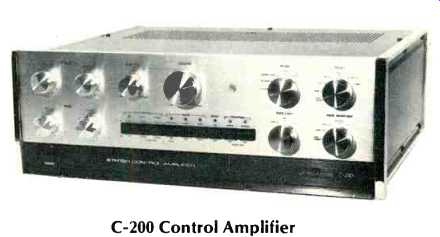
Frequency Response: 20 to 20,000 Hz +0-0.5 dB.
Distortion: 0.05% at rated output level, 20 to 20,000 Hz.
Hum and Noise: Tuner, AUX, and Tape, 90 dB below rated output; Disc and Mike, 64 dB below rated input, 78 below 10 mV input.
Output Level and Impedance: Main, 2.0 v, 200 ohms; Headphones, 0.75 v into 8-ohm load, and Tape Rec., 200 mV, 200 ohms.
Maximum Output: 10 V at 0.05% THD.
Input Sensitivity: Disc 1 & 2, 2 to 6 mV, changeable; Mike, 2 mV; Tuner, 200 mV; AUX, 200 mV, and Tape Play, 200 mV.
Dimensions: 17 1/2 in. W x 6 in. H x 14 in. D.
Weight: 30.8 lbs.
Price: $600.00.
P-300 Power Amplifier
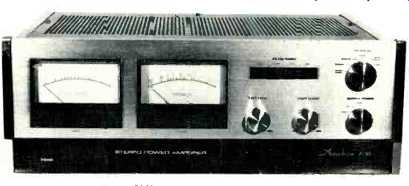
Power Output: 200 watts continuous rms watts per channel into 4 ohms with less than 0.1% total harmonic distortion with both channels operating simultaneously at any frequency from 20 Hz to 20,000 Hz; 150 watts continuous rms watts per channel into 8 ohms with less than 0.1% total harmonic distortion with both channels operating simultaneously at any frequency from 20 Hz to 20,000 Hz.
Intermodulation Distortion: Less than 0.1% at rated output for any combination of frequencies between 20 and 20,000 Hz.
Frequency Response: 20 to 20,000 Hz +0/-0.2 dB at rated output. Input Impedance: 100k ohms.
Input Sensitivity: 0.5 V for rated output at maximum level control.
Damping Factor: 40 at 4 ohms, 20 at 8 ohms for any frequency from 20 to 20,000 Hz.
Dimensions: 17 1/2 in. W x 6 in. H x 14 in. W.
Weight: 55 lbs. Price: $750.00.
The Kensonic Accuphase C-200 control amplifier is a quite attractive, well-built, and very flexible preamplifier which has quite a few very nice features. The construction uses a subplate, about an inch off the bottom, on which are mounted a row of plug-in PC boards, the transformer, filter capacitors, and regulator power transistor heat sinks. There is extensive internal shielding, which was removed for Fig. 1.
The unit appears nicely made, with good quality components. Kensonic claims a 1 dB tracking error between channels in the volume control at any level, and measurement confirmed this, so this is an especially good volume control.
The P-300 power amp is a solidly built unit, weighing about 55 lbs. It also has a sub-chassis like the preamp, on which are mounted the nicely made power transformer, filter capacitors, and four PC boards. Two boards are power amp driver assemblies, containing all the transistors save the output devices; the other two are the protection circuit and the power supply regulator. The side-mounted heat sinks, essentially the height of the unit, are fairly large and have plenty of free-flow ventilation.
The front panel has two VU meters without power scales, however, pushbutton switches change the meter sensitivity from 0 to-10, or-20, zero being for 150 watts at 8 ohms,-10 15 watts, and-20 1.5 watts. This stepping of sensitivity is nice, as it's easy to remember that if you push-10, your scale is a factor of 10 different than the one above. The front panel also has a selector switch which selects Main, Remote 1, Remote 2, Front Panel, or Main and Remote 1.
There are two level control pots, and a power switch which limits the amp to 50% or 25% of full output. On the bottom of the front panel is a nice hinged panel with a magnetic catch. Behind it are phone output and input jacks, a pair of front speaker output banana plugs, a filter switch which limits the bandwidth of the amp, and a switch between front and rear inputs.
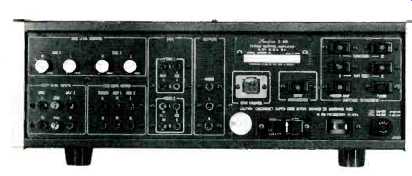
Fig. 1-Rear panel of control/preamplifier.
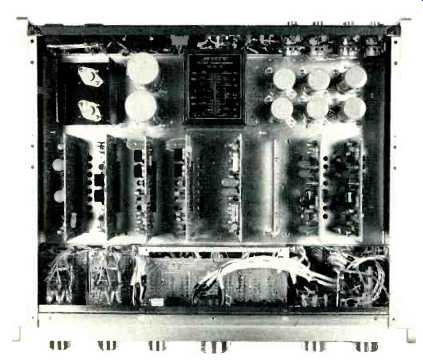
Fig. 2-Inside view of control/preamplifier.
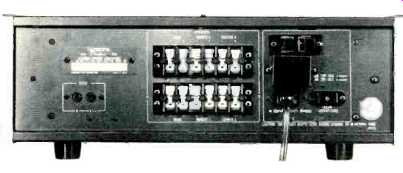
Fig. 3-Rear panel of power amplifier.
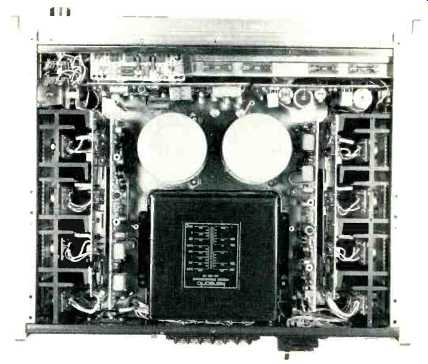
Fig. 4-Inside view of power amplifier.
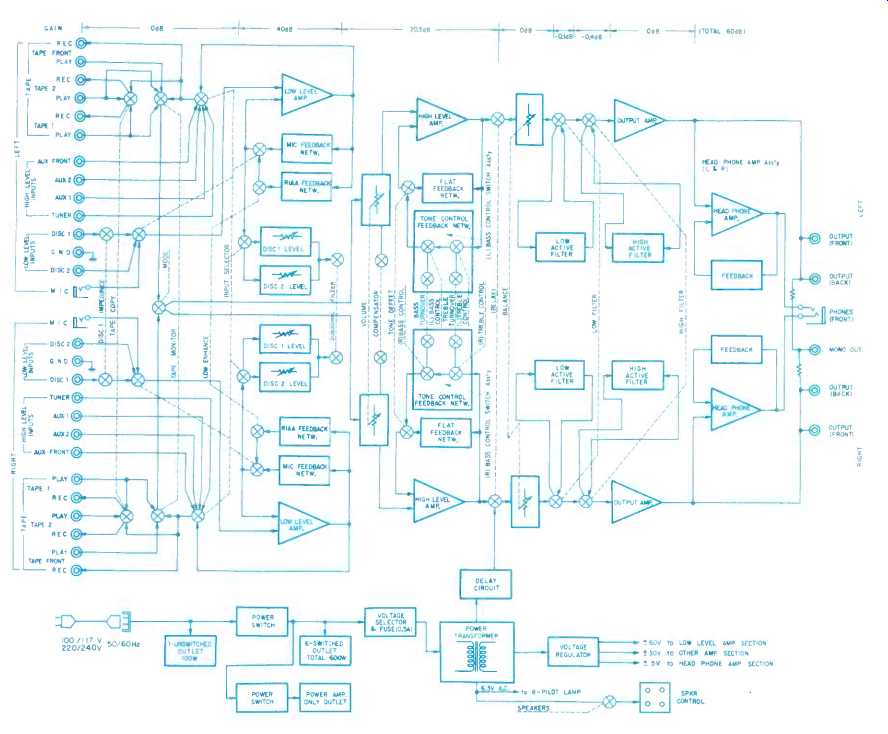
Fig. 5--Block diagram of control/preamplifier. Power supply is shown
at bottom.
On the rear panel is a set of high quality, barrier terminal strips for connection of three speaker sets, a pair of input jacks, a device to select 100, 117, 120, 220 or 240 V a.c., and an unswitched a.c. outlet, and the main a.c. fuse.
Preamplifier Circuitry
The C-200 design is unusual in several respects. First, it uses fully complementary circuitry and may have been the first on the market to do so. The block diagram, shown in Fig. 5, discloses six amp blocks per channel, phono preamp, high level amp also used for tone control action, low- and high-cut active filters, output buffer amp, and headphone amp. In normal use, when you're playing records and don't have the filters in, you go through the phono preamp, the high level amp, and the output buffer amp, making a total of three, with the C-200 driving a following power amp.
When the tone controls are switched in, a flat feedback network in the high level amp is replaced by switched RC networks. There is, therefore, little difference in performance when the tone controls are "in circuit," which is not the case with other designs that typically use another inverting gain-of-one amplifier. The high level amp is always in use, and when you use the tone controls you aren't adding any extra electronics. The high and low filters are, however, bypass switchable.
The C-200's design is also unusual in that the balance control comes after the high level amp, which follows the volume control; usually the balance and volume controls are together in a circuit. There is also a muting relay between the output of the high level amplifier and the balance control, which is connected to a time-delay circuit and prevents turn-on thumps.
The tape monitor facility has a tape-copy switch, separate from the monitor switch, which allows recording from one deck to another, independent of the signal to the speakers.
This is a good feature, rather unusual, and works well.
The headphone amp is connected to the output of the main preamp output and in attenuated to about one-fifth of the main preamp's output voltage. It is a complete power amplifier that can drive 4, 8 or 16 ohm 'phones to about 200 mW. It has a low output impedance so that dynamic phones can get damping. This is unusual as most headphone amp circuits, which come in power amps, drop the feed to the 'phones through a large series resistor, so there is virtually no damping.
Figure 6 is a simplified schematic of the phono preamp, the most elaborate circuit used in the C-200; both the high level and headphone circuits are simplified versions. What is unusual about this phono preamp, aside from fully complementary design, is the high voltage used in the output stage of the preamp,E60 V, which to my knowledge is the highest supply voltage for any present day solid-state preamp output stage. The high supply voltage, combined with the ability to lower the circuit gain from 40 to 30 dB at 1 kHz by means of back channel pots, makes it virtually impossible to overload this phono preamp with any magnetic pickup.
Such unusually high signal acceptance is very good.
Q1 through Q4 form a complementary-differential input amplifier which drives complementary inverting transistors Q5 and Q6. The collectors of Q5 and Q6 have signal currents in phase, but even-order harmonic distortion products are out of phase, and thus cancel-if the devices are completely and perfectly complementary.
Q7 through Q10 constitute a complementary compound [...]
(Source: Audio magazine, Mar. 1975)
Also see: ACCUPHASE C-280 pre-amp and P-600 amp (Aug. 1984)
= = = =